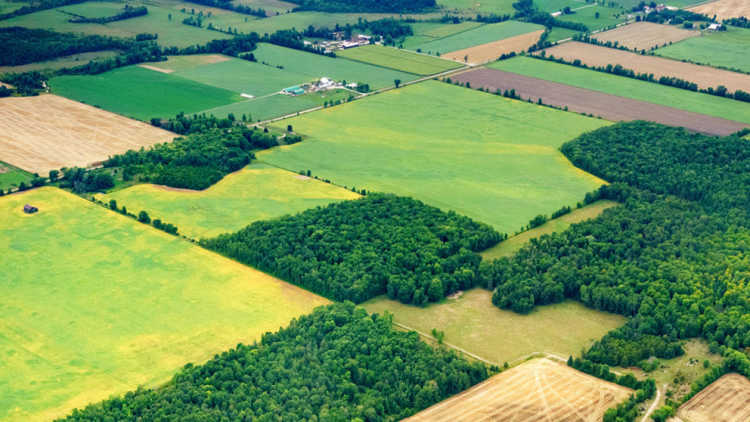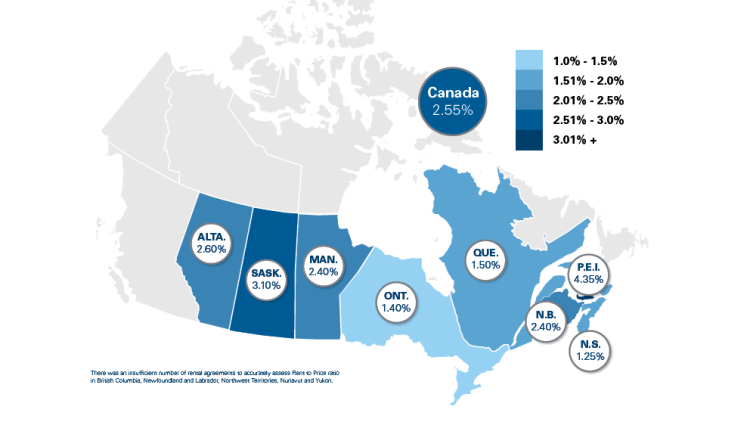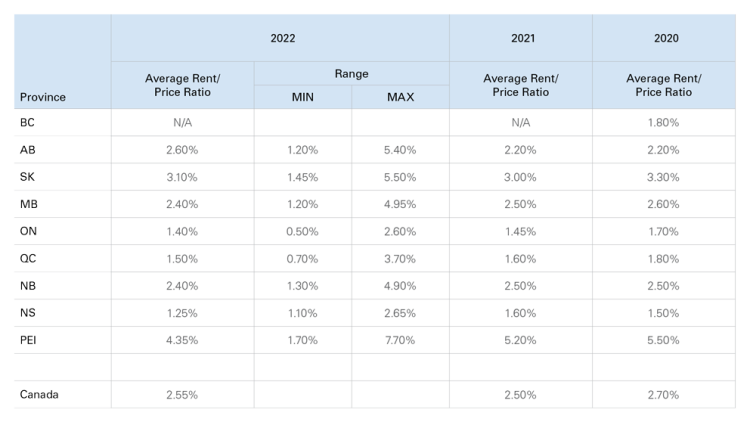2022 farmland rental rates: An overview

Farmland values continued to trend higher in 2022 as demand for farmland remains high and available supply is low. Higher interest rates and farm input prices were offset by strong cash receipts, mitigating profitability pressures on the demand for farmland.
Around 40% of Canadian farmland area is rented. Renting land is a business approach that offers financial flexibility because the financial cost of renting is often lower than buying.
Rent to Price ratio analysis
The analysis below provides an overview of cash rental rates in selected provinces by leveraging the farmland benchmarks from our FCC Farmland Values Report.
The cash rental rate per acre reflects new rental agreements negotiated in the fall of 2022. The weighted average RP ratio of Canadian cultivated land is 2.55% (Figure 1), a slight increase from drought-stricken 2021, however lower compared to 2020.
Figure 1. 2022 Rent to price ratio by province

Source: FCC calculations
Land prices, rental rates, farm revenue, and interest rates tend to move together over the long run, yet the relationship between these variables can be disrupted at any time.
The RP ratio decreased from last year in almost all provinces (Table 1) except for Alberta and Saskatchewan. The land rental market in these two prairie provinces seems to have reacted to changing economic factors. The 2021 RP ratio declined when the region suffered a drought and rebounded in 2022 with good crops.
Often, rental agreements are negotiated between related parties or parties that want to continue their existing business relationship. These can often be done at lower average rates than if the lease were made to a third party which can have higher transaction costs and risks due to unobservable tenant or landlord characteristics.
Table 1. Range of Rent to Price Ratio in each province for 2022 compared to 2021 and 2020

Source: FCC Calculations
There is considerable fluctuation in each province’s cash rental rates and land values. The high-end RP ratio is usually for land with the lowest value per acre in the province. Specialty crops, like potatoes, are generally negotiated at higher prices than other crops.
Relationship between crop revenues and farmland rental rates
Renting may be a great option, especially for young farmers or new entrants, to maximize equipment use, expand their land base, and grow their operation. Buying land can tie up your available capital and reduce cash flow, leaving fewer financing options for machinery, input needs or future expansion opportunities.
The relationship between rental rates and cropland revenues can assist in deciding between renting versus purchasing.
Average provincial yields and crop prices generate an estimate of gross revenues for corn-soybean rotations in Ontario and Quebec and wheat-canola rotations in Alberta, Saskatchewan, and Manitoba. The types of crops grown, quality of farmland, and local market drivers such as availability and land use are all factors that must be considered in establishing land rental agreements.
Rental rates as a proportion of crop revenues have declined since 2020 (Table 2). While renting is generally less expensive than the annual cost of farmland ownership, other issues matter when determining renting vs buying.
Table 2. Farmland rental rates as a proportion of average cropland revenue

Source: FCC Calculations
In 2022, Alberta and Saskatchewan had nearly unchanged rental rates as a percentage of wheat-canola gross revenue. The increases in rental values nearly exactly matched the increases in cropland revenue. However, Manitoba did see cropland revenues increase above the rental rate increase, which pushed down the ratio.
Quebec and Ontario have both seen increased revenue generated from corn-soybean rotations since 2020, and this growth has outpaced increases recorded for rental rates causing the ratio to decline. This analysis ignores the significant increases in input costs farm operations faced in 2021 and 2022 and its impacts on profitability.
High cropland revenues are partially driven by commodity prices significantly above their 5-year average. As these prices potentially work their way back down to historical ranges, farmers should expect the ratio of rental rates to revenue to start increasing. However, farm input prices are notoriously slower to decline than crop prices.
What to expect for farmland rental rates going forward
Business circumstances are unique to each farm operation. Ownership vs. renting is a decision that must meet the business’s strategic objectives. Farmers should consider multiple scenarios regarding patterns in interest rates, yields, commodity prices and input costs, which can influence the decision to buy farmland vs renting. Landlords should also have a vested interest in seeing tenants committed to the land's long-term health. Sound risk management and collaboration between farmers and landowners are required for successful long-term partnerships.
Article by: Lyne Michaud, É.A., Senior Analyst, Valuations and Justin Shepherd, Senior Economist, Economics
